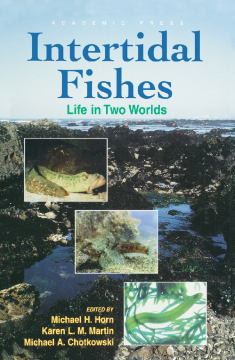
Additional Information
Book Details
Abstract
Intertidal Fishes describes the fishes inhabiting the narrow strip of habitat between the high and low tide marks along the rocky coastlines of the world. It analyzes the specialized traits of these fishes that have adapted to living in the dynamic and challenging space where they are alternately exposed to the air and submerged in water with the ebb and flow of the tides. This book provides a comprehensive account of fishes largely overlooked in many previous studies of intertidal organisms and emphasizes how they differ from fishes living in other deeper-water habitats. Coverage includes air breathing, movements and homing, sensory systems, spawning and parental care, feeding habits, community structure, systematic relationships, distribution patterns, and the fossil record in the intertidal zone.
- Written by an international team of 21 experts on intertidal fish biology
- Worldwide coverage of intertidal fishes
- Comprehensive phylogenetic listing of all fish families with intertidal members
- Global biogeographic analysis involving over 700 species from 86 sites
- Outlines field and laboratory methods pertinent to studying intertidal fishes
- Thorough ecological coverage with chapters on vertical distribution, movements and homing, reproduction, feeding, and community structure
- Covers the physiology of aerial and aquatic respiration, osmoregulation, and sensory systems
"...the authors of Intertidal Fishes are commended for writing the first comprehensive text that I am aware of on the ecology of fishes that inhabit the intertidal. Their work will serve as an excellent reference and springboard for new and exciting studies and ultimately more historic management and conservation of our valuable marine ecosystems." --BIOLOGICAL CONSERVATION, 2000
"Intertidal Fishes offers much in the way of extensive data presentation and interpretation, a wide array of topics, useful (and consistently prepared) graphics, exhaustive reference lists and provocative ideas for future work. This book and Graham's most readable text on air-breathing fishes in particular, provide a state-of-the-science summation of what is known of the intertidal fishes, pointing to much interesting and important work to come." --TREE, 2000
"Intertidal marine fishes have always been relatively well-known because they are easy to capture and observe. But until now no one has attempted to bring together in one volume the existing information about their biology. Editors Horn, Martin, and Chotkowski have succeeded in organizing a comprehensive treatment that covers virtually all aspects of intertidal adaptation." --CHOICE, June 1999
"...each chapter can stand alone as a strong review article, making the book as a whole effective as both a teaching tool and an original scholarly synthesis of modern research. This volume is very comprehensive, and it is difficult to find a better way of synthesizing the current literature on intertidal fishes. I strongly recommend this volume for ichthyologists, physiological ecologists, coastal nautralists, and anyone interested in studying a unique group of fishes." --COPEIA, 1999
"...an extensive and authoritative review of the current state of knowledge about this fascinating and often overlooked group of animals. This is a practical manual offering sound advice and aiming to raise awareness. In its primary aim of stimulating greater interest in the group, this book will certainly succeed. In suggesting that these fish, being sensitive to the effects of disturbance, might even prove to be useful indicators of the health of intertidal habitats, the authors might even have achieved a wider success." --ZOOLOGICAL JOURNAL OF THE LINNEAN SOCIETY, 1999
"This book will be welcomed by all marine biologists concerned with littoral and coastal ecosystems, both as teachers and researchers. This is quite probably the first comprehensive treatment of the biology of littoral fishes, and the editors are to be congratulated on their achievement." --JOURNAL OF NATURAL HISTORY, 1999
